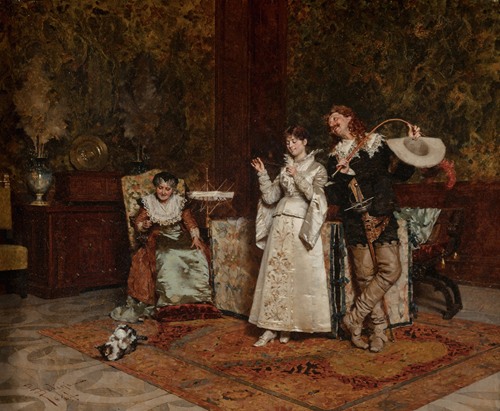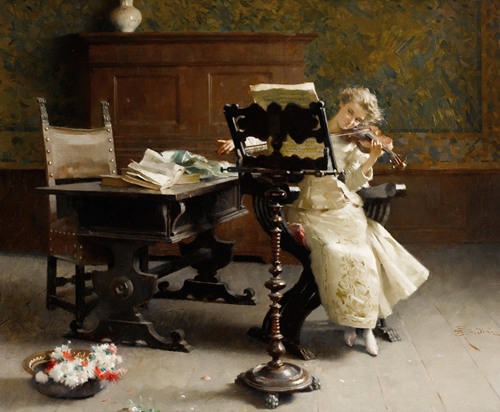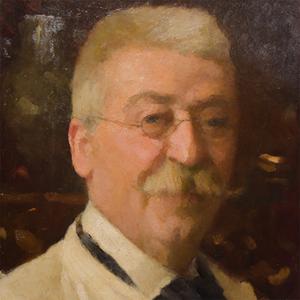




Giovanni Paolo Bedini was an Italian painter. He is best known for his watercolor works.
Giovanni Paolo Bedini was born in Bologna on December 25, 1844, the third-born son of Filippo Bedini and Orsola Zacchi. He attended the National Academy of Fine Arts in Bologna beginning in 1862, where he immediately showed himself to be particularly versatile and gifted, especially in architectural perspective and figure exercises. Works such as Interno Rinascimentale (c. 1865-67) and Interno di palazzo senatorio e cortile (c. 1865-70) date from this period, the latter already indicative of a particular aptitude for and mastery of the watercolor technique.
He made his debut in 1867, while still a student at the Academy, at the II Triennial Exhibition of the Academies of Emilia, held in Reggio Emilia, during which he presented two works in the historical genre, which at the time was still particularly popular; in one of the two works one could already recognize one of the traits that would later become his stylistic hallmark, the attention to detail and the splendid rendering of domestic environments and their intimacy and everyday life.
He later exhibited in Turin (1872), Ferrara (1875), Genoa (1876), Florence (1877) and Milan (1876, 1893, 1895, 1906).
In the years following his graduation in 1870, he stayed abroad several times in the company of Mario de Maria, Luigi Serra and Raffaele Faccioli, in Austria, Germany and France, which enabled him to forge relationships with local art dealers (with an important collaboration with Goupil) and to draw inspiration from the German post-romantic and verist artists and French genre painters to whom he was exposed (among them, special mention should be made of Adolph von Menzel and Carl Spitzweg, but especially Jean-Georges Vibert and Jean-Louis-Ernest Meissonier).
Establishing himself as a painter and receiving several prizes and critical appreciation during exhibitions (including, already very young, that in Architecture in 1863, in Decoration and Figure in 1864, in Perspective in 1865, in Painting in 1866 and in Figure of Statues and Anatomy in 1867), he founded in 1885, together with the Circolo Artistico Bolognese, the Scuola Professionale per Arti Decorative (which later became Regia Scuola per Industrie Artistiche di Bologna, later named Istituto d'Arte and finally merged in 2000 with the Liceo Artistico Francesco Arcangeli), of which he was first a teacher and then Head of Institute from 1907 to 1922. In 1894 he was also called to teach Elements of Figure at the Bologna Academy.
His career reached its crowning point in the 1890s, a period when he produced his best works, such as La nuova composizione (c. 1890-95) and La violinista (c. 1890-1900).
Also in the last decade of the 1800s he devoted himself to the production of advertising graphics and portraiture, reducing his production of watercolors. During this period he looked with interest at the techniques of the scapigliatura.
Datable to the first decade of the 1900s, however, are the slight impressionistic and Macchiaioli influences visible in the works Rimembranze and La ricamatrice.
There are no attested records regarding the later part of Bedini's life; what is known, however, is that after a fair amount of artistic success, he died destitute, without a will.
He died of a bout of chronic bronchitis on March 14, 1924, with his daughter Giulia by his side, who inherited her father's drawings, sketches and paintings.
His ashes are currently in the Cinerary of the Cortile of the Monumental Cemetery of the Certosa di Bologna.


